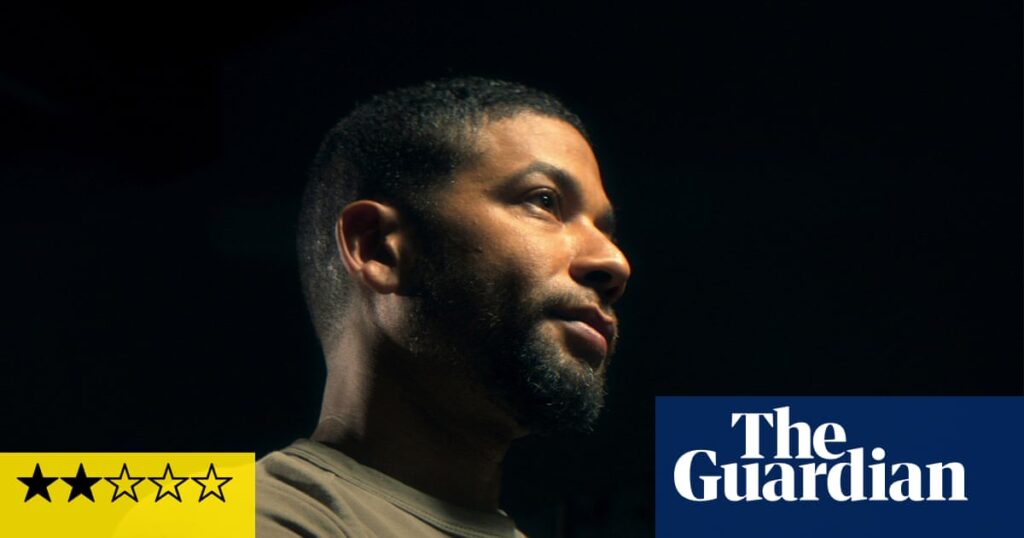In January 2019, news outlets across the world reported that the actor Jussie Smollett had been the victim of a particularly vile and disturbing hate crime. Smollett – who was, at the time, best known for his leading role in Fox’s music drama Empire – had been set upon in the early hours of the morning in his Chicago neighbourhood by two white men who had racially and homophobically abused him (Smollett is gay and mixed race). During a bitter cold snap in the city, the men had poured bleach on him and even tied a noose around his neck, while declaring they were in “Maga country”. The resulting deluge of support for Smollett is recounted in the opening of this documentary, with even Donald Trump describing the attack as “horrible … it doesn’t get any worse”.
These days, Smollett is no longer best known for his role on Empire but for his participation in what is widely understood to have been a hoax, organised by the actor and carried out for a fee by two acquaintances, brothers Akimbola (Bola) and Olabinjo Osundairo (Ola). The idea the Osundairos – who are of Nigerian heritage – had perpetrated a fake white supremacist attack made the case into instant meme fodder, while subsequent legal proceedings saw Smollett charged with having staged the whole thing.
But is that what really happened? The Truth About Jussie Smollett? – a 90-minute documentary from the makers of such Netflix hits as The Tinder Swindler – teases the possibility of something more sinister. It asks whether the actor was the victim of a conspiracy at the heart of the city’s criminal justice system, that turned him from victim to perpetrator. It’s bold, it’s shocking – and it’s utter nonsense.
Things start out convincingly enough, with testimonies from senior figures from the Chicago police department. They outline the facts of the case, as well as the inconsistencies that troubled them. Or, as the then-superintendent Eddie Johnson puts it, why would anyone have left their home “when it’s cold as shit?” Smollett had bought a sandwich, a meal that survived the attack (we see CCTV footage of him walking back into his apartment building with a Subway bag in his hand). It wasn’t conclusive, but it seemed – at the very least – odd.
Rider data from Uber led the police to the Osundairos, aspiring actors who – conveniently – had flown to Nigeria the day after the attack. Footage of Smollett crying during a TV interview is juxtaposed with that of the police apprehending the brothers on their return to the US. We meet them in the present day – Ola is spaced out, while Bola modestly describes himself as “an all-round great human being”. Being hired to beat someone up was, they say, the sort of thing they assumed happened all the time in Hollywood. Plus, they allege, the idea was to give Smollett a leg-up in becoming an activist. For his part, Smollett is interviewed throughout, looking morose as he relays his version of events to camera. He insists a cheque he made out to the brothers was actually payment for fat-busting herbal steroids they would procure for him back in Nigeria, and says his life descended into a game of “whack-a-mole” in the face of rumours and lies.
The Osundairos ultimately avoided any criminal charges. Smollett, meanwhile,drafted in a lawyer whose client list reads like a roll call of the most problematic public figures of our time, including Andrew Tate and Chris Brown. He was written out of Empire, then reached a plea deal with the city of Chicago that involved him sacrificing his bail money and doing community service. But then he was tried again and sent to jail, only for a court to find it unlawful that he was tried twice on the same charges and decide to overturn his conviction.
This, arguably, is where The Truth About Jussie Smollett? should end – but it just keeps going, becoming increasingly icky and irresponsible. The final act is given over almost entirely to talking heads Abigail Carr and Chelli Stanley, who weave conspiracy theory and conjecture together as they claim the Chicago police framed Smollett. After all, two eyewitnesses were given short shrift by the police, and there’s some grainy footage where the suspects look as though they could, maybe, be white. We are told, too, about the police’s worrying record on race (quelle surprise), and the fact that Johnson (who is black) was fired for misconduct. It feels more than a little problematic to link Johnson – fired for drinking on the job – with a plot to purposely incriminate Smollett and the Osundairos while letting two hypothetical white criminals off the hook, and there is no evidence here to say that was what happened.
Stanley is a freelance journalist who has written a handful of articles on Smollett, while Carr is a British TV documentary producer. How they came to be authorities on the case is never explained, and their contributions feel far too lightweight to justify the screen time given to them. (The credits reveal that both are consultant producers.) The final revelation is that Bola and Ola have written a tell-all book: cue some blooper-style scenes of them trying to remember what it’s actually called. The implication seems to be that the brothers have exploited their brush with infamy for financial gain, and thrown Smollett under the bus. But, really, a programme like this has no business taking the moral high ground at all.

